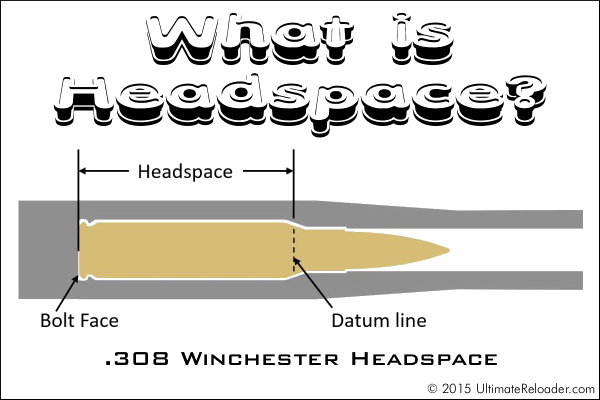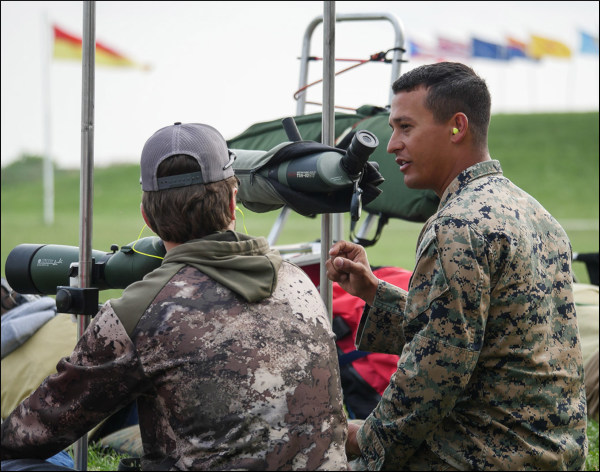Headspace Basics — What You Need to Know

This illustration shows headspace measurement for the popular .308 Winchester cartridge, which headspaces on the shoulder. Image copyright 2015 Ultimate Reloader.
In this Brownells Tech Tip Video, Brownells gun tech Steve Ostrem explains what headspace is and why it’s one of the most critical measurements for nearly all firearms. Even if you’re an experienced rifle shooter, it’s worth watching this video to refresh your understanding of headspace measurements, and the correct use of “GO” and “NO-GO” gauges.
Headspace Definition
In firearms, headspace is the distance measured from the part of the chamber that stops forward motion of the cartridge (the datum reference) to the face of the bolt. Different cartridges have their datum lines in different positions in relation to the cartridge. For example, 5.56x45mm NATO ammunition headspaces off the shoulder of the cartridge, whereas .303 British headspaces off the forward rim of the cartridge. If the headspace is too short, ammunition that is in specification may not chamber correctly. If headspace is too large, the ammunition may not fit as intended or designed and the cartridge case may rupture, possibly damaging the firearm and injuring the shooter. (Source: Wikipedia)

Problems Caused by Too Much Headspace
Excessive headspace issues can include: light primer strikes, failure to fire, bulged/blown cases, case separations, split shoulders, or unseated primers after firing. Case ruptures caused by excessive headspace can lead to catastrophic failures causing serious injury. That is why headspace is such an important measurement.
Problems Cause by Too Little Headspace
Insufficent (or excessively tight) headspace can prevent the firearm from going into battery, resulting in failure to fire or deformation of the cartridge case. Various feeding and functioning problems can be caused by cases with too little headspace, even if a round can be chambered (with effort).
 Headspace Gauges
Headspace Gauges
Headspace is measured with a set of two headspace gauges: a “Go” gauge, and a “No-Go” gauge. Headspace gauges resemble the cartridges for the chambers they are designed to headspace, and are typically made of heat-treated tool steel. Both a “Go” and a “No-Go” gauge are required for a gunsmith to headspace a firearm properly. A third gauge, the “Field” gauge, is used (as the name implies) in the field to indicate the absolute maximum safe headspace. This gauge is used because, over time, the bolt and receiver will wear, the bolt and lugs compress, and the receiver may stretch, all causing the headspace to gradually increase from the “factory specs” measured by the “Go” and “No-Go” gauges. A bolt that closes on “No-Go” but not on “Field” is close to being unsafe to fire, and may malfunction on cartridges that are slightly out of spec. (Source: Wikipedia)
To learn more, read Brownell’s article Headspace Gauges and How to Use Them. Among other things, this explains the relative lengths of “Go”, “No-Go”, and “Field” gauges. The “Field” is actually the longest: “The GO gauge corresponds to the SAAMI minimum chamber length, while the FIELD gauge usually matches the maximum chamber depth, or slightly less. NO-GO gauges are an intermediate length between minimum and maximum, that, technically, is a voluntary dimension. A firearm that closes on a NO-GO gauge and does not close on a FIELD gauge may not give good accuracy and may have very short cartridge case life from the ammunition re-loader’s standpoint.”


















 2. Set a Goal and a Plan. When I attend a shooting competition I have a goal in mind and a plan for how I want to get there. This varies on what shooting sport it is. I may have the goal that I want to place in the top half of the shooters in my division. In order to achieve that goal I may have decided that I need to concentrate on accuracy. When you set goals and plans they need to reflect all of the work you have been doing. For instance, it does not make sense to say “I will win everything” if you haven’t practiced in four years. It is important to set achievable but still challenging goals.
2. Set a Goal and a Plan. When I attend a shooting competition I have a goal in mind and a plan for how I want to get there. This varies on what shooting sport it is. I may have the goal that I want to place in the top half of the shooters in my division. In order to achieve that goal I may have decided that I need to concentrate on accuracy. When you set goals and plans they need to reflect all of the work you have been doing. For instance, it does not make sense to say “I will win everything” if you haven’t practiced in four years. It is important to set achievable but still challenging goals. As I head into a major competition my mental plan is to [remember] “Sights” and “Stay Aggressive.” I want to make sure I am remembering to look at my sights and shoot accurately, but I also want to make sure that I am not getting lazy. I need to move and shoot as fast as possible while still making my hits. As for my goal, I will keep that a secret for now.
As I head into a major competition my mental plan is to [remember] “Sights” and “Stay Aggressive.” I want to make sure I am remembering to look at my sights and shoot accurately, but I also want to make sure that I am not getting lazy. I need to move and shoot as fast as possible while still making my hits. As for my goal, I will keep that a secret for now.




